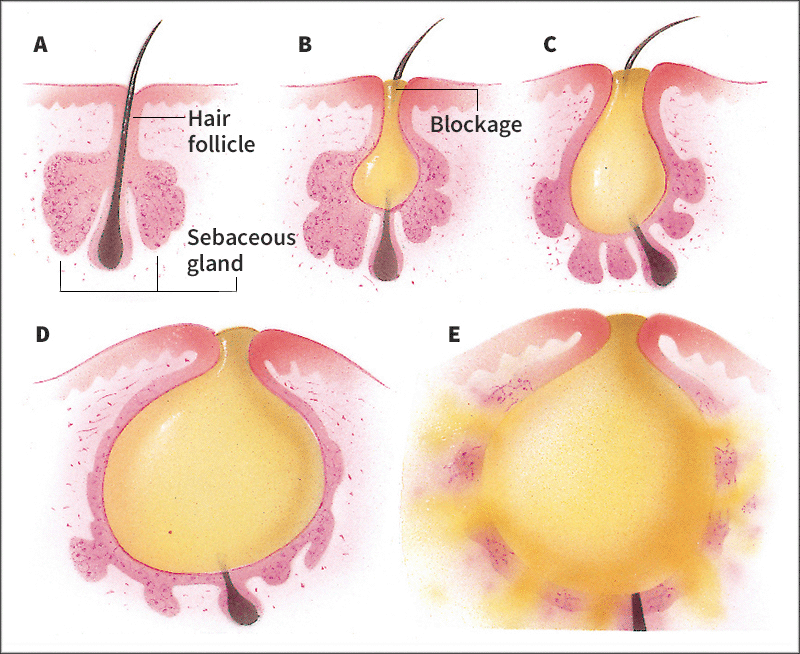Good Bacteria Zap Zits
March 5, 2013
Not all strains of acne bacteria are created equal, medical researchers at the University of California at Los Angeles (UCLA) have found. The bugs that cause acne can sometimes help prevent zits.
For teenagers, acne is often a dreaded fact of life. More than 80 percent of teens at some point suffer from the skin condition, which cause pimples and red, inflamed skin. Acne is caused mainly by a type of bacteria called Propionibacterium acnes that naturally resides in the follicles and pores of skin, especially on the face. Zits occur when the bacteria feed on oils in the pores. This prompts an inflammatory response from the immune system, causing the characteristic redness and unsightly pimples.

The development of an acne pimple: Figure A (top left) shows a normal hair follicle and sebaceous gland. In figure B (top center), a blockage prevents the flow of oil out of the hair follicle. Bacteria breed in the backed-up oil. In figures C and D (top right and bottom left), the follicle swells with pus. The walls of the follicle eventually burst, and the pus drains away, as shown in figure E (bottom right). (Book illustrations by Charles Wellek)
Doctors often treat problem acne with antibiotics that kill P. acnes bacteria. However, billions of bacteria reside on the skin surface, and it is impossible to eliminate them all. Antibiotics don’t always reach into the pores on the surface. Antibiotics also kill bacteria indiscriminately, knocking off helpful bacteria as well.
In the study, UCLA molecular biologist Huiynig Li and her colleagues took samples of bacteria from 101 volunteers using ordinary adhesive pore-cleansing strips. Some of the volunteers had acne while others had clear skin. Li and her team expected to find that the volunteers with acne had greater quantities of P. acnes bacteria in their pores. Instead, they found that all volunteers had a similar abundance of P. acnes. Using DNA analysis techniques, the researchers identified several different strains (varieties) of P. acnes among the volunteers. More importantly, they found that not all of the strains of P. acnes were the same. Two of the newly identified strains, called RT4 and RT5, were found mainly in volunteers with acne. However, another strain, called RT6, seemed to work to keep skin clear and healthy. This strain was found almost exclusively in volunteers with no acne.
The discovery that some strains of P. acnes bacteria are actually helpful may help dermatologists develop new treatments for acne. They may be able to develop medication that targets the bad strains while sparing the good strains. Probiotic lotions, which promote the growth of protective strains, may offer a way to achieve clear skin without antibiotics or other harsh topical medications.
Additional World Book articles:
- Abscess
- Boil
- The Passage Through Puberty (a special report)


